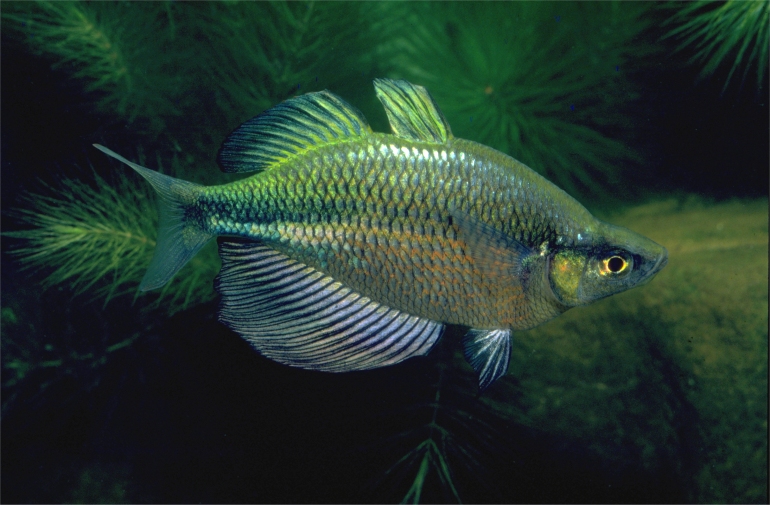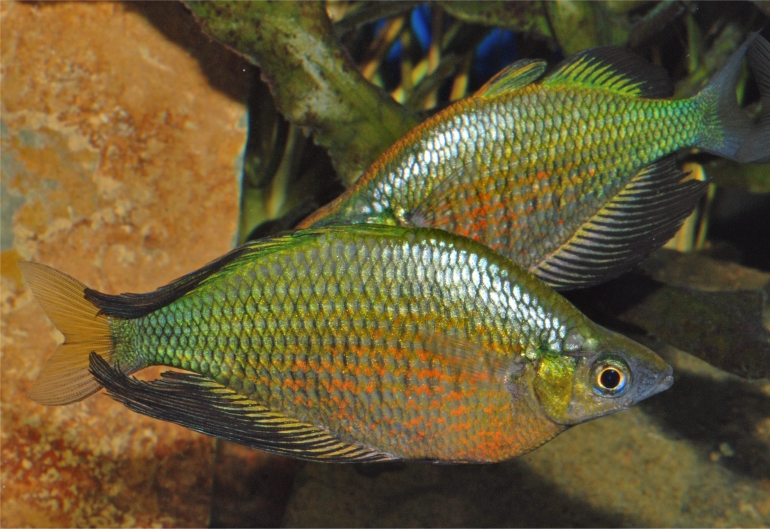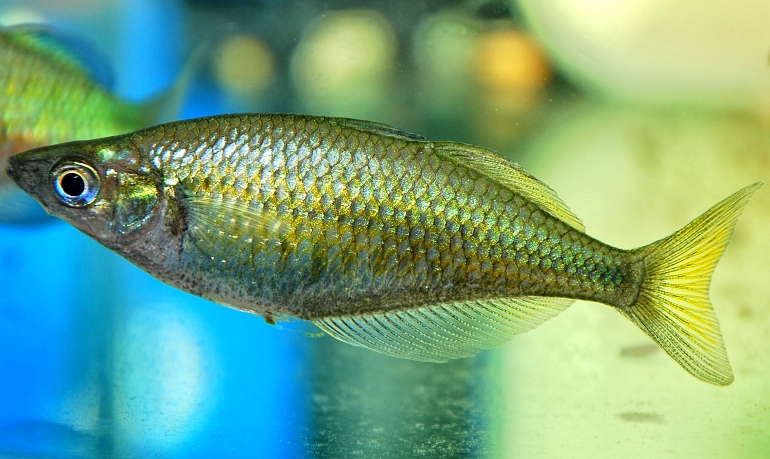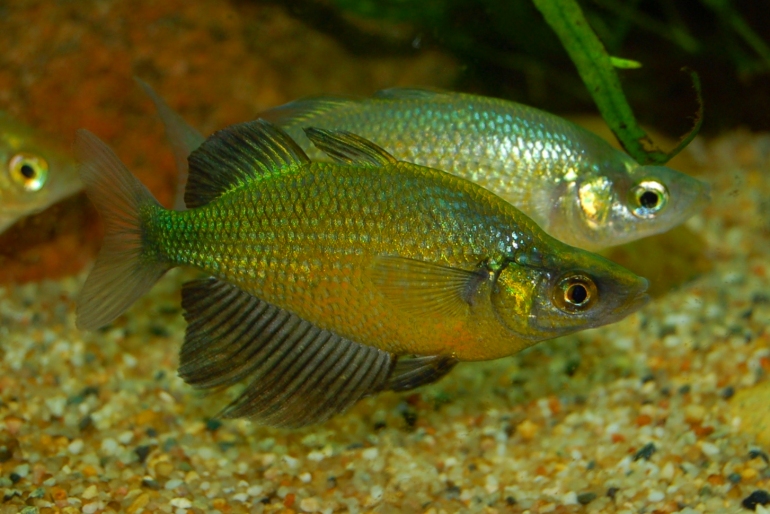|
 |
Glossolepis wanamensis - photo© Neil Armstrong |
Allen and Kailola, 1979
Lake Wanam Rainbowfish
Species Summary
Generally, the body colour of adult males of Glossolepis wanamensis is an overall greenish colour with a rosy flush on the breast. The anterior scale rows below the lateral line are marked with narrow orange lines becoming green or bluish towards the tail. The upper half of the body often shows a metallic green colouration. The anal fin of the male is very large and elongated reaching a depth of nearly 3 cm. Females are generally a dull greenish colour, have shorter fins and rather drab compared to the males. Males are easily distinguished from females by their brighter colours and the extremely large anal fin. Males may reach a maximum size of 10 cm, but females are usually less than 8 cm. With a body depth of 4-5 cm, adults become very deep bodied especially the males.
Distribution & Habitat
Glossolepis wanamensis has only been found in Lake Wanam. They were collected in shallow, clear, sunlit water around sub-surface vegetation, submerged logs, and branches, or among reeds and other shoreline vegetation. The temperature and pH recorded at the lake was 28° Celsius and pH 7.0-7.8. Lake Wanum is a freshwater lake centred on 6° 38'S and 146° 47'E, and located in the vicinity of Mount Ngaroneno, at the southern margin of the lower Markham Valley, near Oomsis, Morobe Province about 25 km inland from the Huon Gulf. It has an irregular outline and, with a maximum width of about 3 km, is the largest of a number of lakes and swamps in the vicinity.
As there is no permanent stream inflow into the lake much of its water is derived by precipitation directly onto the lake surface. The lake has a maximum depth of around 19 metres, and is subject to seasonal fluctuations in level. The only outflow of the lake is a small channel in the extreme south-west corner of the basin that runs into Oomsis Creek. This flows only intermittently and often dries out completely in the dry season when the level of the lake becomes lower. This channel also serves as an inflow when the creek is in flood. Oomsis Creek is the only permanent watercourse in this locality but it too may cease flowing under seasonal conditions of sustained dry weather.
 |
Glossolepis wanamensis - photo© Leo O'Reilly |
Remarks
Lake Wanum is home to two rainbowfishes, Glossolepis wanamensis and Chilatherina fasciata. Glossolepis wanamensis was first collected by C. Ellway in 1975 but it wasn't until 1979 that they were scientifically described. This followed their collection by Gerald Allen and Brian Parkinson in October 1978. Brian Parkinson had previously collected specimens there and sent them to Patricia Kailola, then working for the Fisheries Department at Port Moresby. Fifty-five specimens of Glossolepis wanamensis and four specimens of Chilatherina fasciata were collected. After just two days there were only five survivors and of these only two made it back to Australia. Barry Crockford brought more live specimens to Australia in 1980. Five survived, which included 2 females. A year later further live specimens were collected. The fish collected on these two trips formed the breeding stock of all Glossolepis wanamensis in Australia to the present day. Water conditions at the time were reported as pH 7.6, temperature 28°C and hardness 80 ppm.
In 1992, Heiko Bleher collected live specimens from the lake and introduced them to the European hobby. He again collected in 1994 and reported that "An exhaustive search produced just one small group of rainbowfishes, adults 2-3 years old, seven males and a single elderly female. No juveniles, no eggs. The water was murky from surface to substrate, with tilapias as far as the eye could see." He returned in 1995 and noted that Tilapia infestation of the Lake had increased even further and only two very old male specimens were collected. He reported in Aqua Geðgraphia (1998), that Glossolepis wanamensis was becoming extinct in the Lake. It was thought that the introduction of carp, tilapia, and gambusia may have caused this drastic and worrying reduction in numbers. Oreochromis mossambica were introduced into the lake by the Department of Agriculture, Stock and Fisheries reportedly during 1966, and their increasing population may have made some impact on the lake's ecosystem.
 |
Glossolepis wanamensis [female] - photo© Leo O'Reilly |
During the 1998 ANGFA Convention in Brisbane, discussions were held with Heiko Bleher about the situation at Lake Wanum and it was decided that further survey work would need to be undertaken. It was felt that the endemic Lake Wanum rainbowfish was in such low numbers as to cause concern for its future in the wild. Matt Vincent and Gary Slater from the Melbourne Zoo travelled to PNG to discuss the problem with Peter Clarke, Director of the Rainforest Habitat in Lae. These discussions led to the setting up of a tripartite agreement between ANGFA, Melbourne Zoo and the Rainforest Habitat. These three bodies formed the Lake Wanum Management Project on 21 December 1998.
An extensive survey of Lake Wanum was undertaken in June of 1999. The results of this survey can be found in Fishes of Sahul 13(3): 621-629. This survey found that Glossolepis wanamensis were in reasonably large numbers in the lake, but that the Chilatherina fasciata found in the lake on previous collecting trips had all but disappeared. Despite extensive sampling of areas known to contain hundreds of specimens in the past, not a single fish was collected. However, among all the Glossolepis wanamensis collected only two juvenile specimens were noted. The remainder of the Glossolepis wanamensis were approximately two years of age. The survey team noted small groups of fry but was concerned by the low numbers within these groups (approx 20 specimens).
It was thought that during a severe El Niño drought in 1997, when water levels fell by 11.2 metres, it caused a massive fish kill in the lake. Apparently dead fish were floating everywhere and thick on the shoreline. Glossolepis wanamensis are known to withstand high temperatures and perhaps this event allowed the population to recover temporarily. However this fluctuation in population numbers did highlight the vulnerability of this species and it was decided to establish a separate breeding population at the Rainforest Habitat in Lae.
About eighty Glossolepis wanamensis were collected from Lake Wanum. Oomsis Creek was also surveyed and about twenty Chilatherina campsi were collected. Both collections were taken back to the Rainforest Habitat. Glossolepis wanamensis did not travel well and some losses occurred. The fish were placed into a tank and treated with medication. Chilatherina campsi travelled better and most of these were released directly into the ponds at the Rainforest Habitat. The following day the fish seemed to have improved, but more losses occurred (mostly females). About ten Glossolepis wanamensis were released into a pond in the Butterfly House and these improved dramatically so it was decided to select the best and fittest females from the tank and place these in that pond. It appeared at the time that the pond fish were surviving and that a breeding colony would be achieved. However, the current situation at the Rainforest Habitat and its rainbowfish breeding program is unknown.
The current situation in Lake Wanum and its rainbowfish inhabitants is also unknown. Very little information on the lake and the health of its ecosystem is available. However, small captive populations of Glossolepis wanamensis and Chilatherina fasciata from Lake Wanum still exist in the Australian hobby and internationally.
 |
Glossolepis wanamensis - photo© Christophe Mailliet |
Literature
Allen G.R. & P.J. Kailola (1979) Glossolepis wanamensis, a new species of freshwater rainbowfish (Melanotaeniidae) from New Guinea. Revue française d'Aquariologie 6(2): 39-44.
Bleher H. (1998) Wanam. Aqua Geõgraphia 16:88-95.
Crockford B. (1985) Glossolepis wanamensis. Fishes of Sahul 3(2): 113-116.
Crockford B. (1999) Lake Wanam revisited - a habitat under threat. Lake Wanam survey. Fishes of Sahul 13(3): 621-629.
Crockford B., P. Littlejohn and M. Vincent (1999) The Lake Wanam rainbowfish, Papua New Guinea field expedition. Fishes of Sahul 13(3): 629-638.
Crockford B. (2001) Lake Wanam fasciata Chilatherina fasciata, a subspecies in trouble. Fishes of Sahul 15(3): 776-779.
Gafsett-Jones S.E. (1979) Evidence for Changes in Holocene Vegetation and Lake Sedimentation in the Markham Valley, Papua New Guinea. Thesis submitted for the degree of Doctor of Philosophy at the Australian National University.
Vincent M (1999) Assessing the status of the Lake Wanam Rainbowfish. Concerning Conservation 1:2 World Wide Web electronic publication: http://www.zoo.org.au/
Whitley G.P. (1957) Fishes from inland New Guinea. Records of the Australian Museum 24(3): 23-30.
Adrian R. Tappin
Updated August, 2015



|

